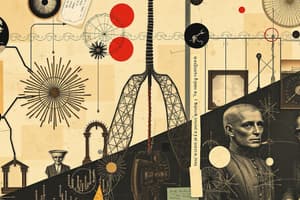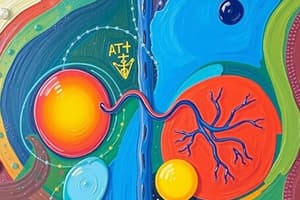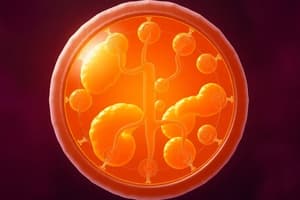Podcast
Questions and Answers
What is the primary role of glucose in plants?
What is the primary role of glucose in plants?
- To produce oxygen through cellular respiration
- To aid in photosynthesis absorption
- To fuel cellular processes (correct)
- To serve as a carbon source for atmospheric reactions
How do the products of photosynthesis relate to the reactants of cellular respiration?
How do the products of photosynthesis relate to the reactants of cellular respiration?
- Photosynthesis produces energy, while respiration consumes it
- They are completely unrelated processes
- They involve the same chemical compounds in reverse order (correct)
- They generate waste products that are used by the other process
Which of the following describes the relationship between photosynthesis and cellular respiration?
Which of the following describes the relationship between photosynthesis and cellular respiration?
- Photosynthesis occurs at night, while respiration occurs during the day
- They are reverse processes that rely on each other's products (correct)
- Photosynthesis produces carbon dioxide while respiration produces glucose
- They are independent processes that do not affect each other
Which of the following is a product of cellular respiration?
Which of the following is a product of cellular respiration?
What are the major types of photosynthesis mentioned?
What are the major types of photosynthesis mentioned?
What is the primary purpose of cellular respiration?
What is the primary purpose of cellular respiration?
Where does glycolysis occur within a cell?
Where does glycolysis occur within a cell?
Which stage of cellular respiration directly produces electron carriers NADH and FADH2?
Which stage of cellular respiration directly produces electron carriers NADH and FADH2?
What role do NADH and FADH2 play during the electron transport chain?
What role do NADH and FADH2 play during the electron transport chain?
What is the result of anaerobic respiration?
What is the result of anaerobic respiration?
Which process is involved in converting carbon dioxide into glucose during photosynthesis?
Which process is involved in converting carbon dioxide into glucose during photosynthesis?
What is produced as a by-product of the light-dependent reactions in photosynthesis?
What is produced as a by-product of the light-dependent reactions in photosynthesis?
Which factor does NOT affect the rate of photosynthesis?
Which factor does NOT affect the rate of photosynthesis?
Flashcards
Photosynthesis
Photosynthesis
The process by which plants use sunlight, carbon dioxide, and water to produce glucose and oxygen.
Cellular Respiration
Cellular Respiration
The process by which cells break down glucose to produce ATP, the energy for cellular processes.
Interdependence of Photosynthesis and Cellular Respiration
Interdependence of Photosynthesis and Cellular Respiration
The products of photosynthesis are the reactants of cellular respiration, and vice versa. This means that the two processes are interconnected and rely on each other.
C3 Photosynthesis
C3 Photosynthesis
Signup and view all the flashcards
C4 Photosynthesis
C4 Photosynthesis
Signup and view all the flashcards
Glycolysis
Glycolysis
Signup and view all the flashcards
Krebs Cycle (Citric Acid Cycle)
Krebs Cycle (Citric Acid Cycle)
Signup and view all the flashcards
Electron Transport Chain
Electron Transport Chain
Signup and view all the flashcards
Light-Dependent Reactions
Light-Dependent Reactions
Signup and view all the flashcards
Light-Independent Reactions (Calvin Cycle)
Light-Independent Reactions (Calvin Cycle)
Signup and view all the flashcards
ATP (Adenosine Triphosphate)
ATP (Adenosine Triphosphate)
Signup and view all the flashcards
Study Notes
Cellular Respiration
- Cellular respiration is the process by which cells break down glucose to produce ATP (adenosine triphosphate), the primary energy currency of cells.
- It's a catabolic process that releases energy stored in the chemical bonds of glucose.
- There are three main stages: glycolysis, the Krebs cycle (citric acid cycle), and the electron transport chain.
- Glycolysis occurs in the cytoplasm and involves the breakdown of glucose into two molecules of pyruvate.
- The Krebs cycle takes place in the mitochondrial matrix and further oxidizes pyruvate, producing NADH and FADH2 (electron carriers).
- The electron transport chain occurs in the inner mitochondrial membrane. Electron carriers (NADH and FADH2) transfer electrons, creating a proton gradient that drives ATP synthesis through chemiosmosis.
- Aerobic respiration requires oxygen as the final electron acceptor in the electron transport chain. Anaerobic respiration (fermentation) occurs without oxygen.
- Cellular respiration is highly efficient, producing a significantly larger amount of ATP compared to fermentation.
- Different types of cellular respiration exist depending on the starting molecule, but they all involve oxidation and reduction reactions releasing energy and creating usable energy for the cell.
Photosynthesis
- Photosynthesis is the process by which plants and some other organisms use sunlight to synthesize foods from carbon dioxide and water.
- It's an anabolic process that stores energy from sunlight in the chemical bonds of glucose.
- Two main stages: the light-dependent reactions and the light-independent reactions (Calvin cycle).
- The light-dependent reactions occur in the thylakoid membranes of chloroplasts. Sunlight energy is captured by chlorophyll and other pigments, splitting water molecules and producing ATP and NADPH.
- Oxygen is released as a by-product of water splitting during the light-dependent reactions.
- The light-independent reactions (Calvin cycle) occur in the stroma of chloroplasts. ATP and NADPH from the light-dependent reactions provide the energy to convert carbon dioxide into glucose.
- Photosynthesis requires carbon dioxide as a source of carbon atoms for glucose synthesis.
- The rate of photosynthesis is affected by factors such as light intensity, temperature, and carbon dioxide concentration.
- Oxygen is a byproduct of this reaction, and organisms use that process for respiration.
- Plants use the glucose produced to fuel cellular processes.
- There are different types of photosynthesis including, C3, C4, and CAM, with variations within the pathways of carbon fixation in different places.
Relationship Between Cellular Respiration and Photosynthesis
- Photosynthesis and cellular respiration are essentially reverse processes.
- Photosynthesis uses sunlight to produce glucose, while cellular respiration breaks down glucose to produce ATP, the energy for cellular processes.
- The products of one process are the reactants of the other.
- Photosynthesis produces glucose and oxygen. Cellular respiration uses glucose and oxygen and produces carbon dioxide and water.
- The interdependence between photosynthesis and cellular respiration is crucial for life on Earth as it cycles essential elements between the living world and the atmosphere.
Studying That Suits You
Use AI to generate personalized quizzes and flashcards to suit your learning preferences.




